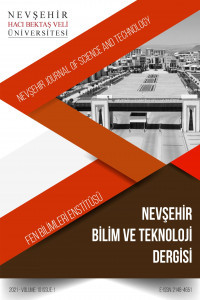Farklı Oranlarda Si İçeren TRIP Çeliğinin Mig-Mag Kaynak Tekniği İle Kaynağı ve Mikroyapısının İncelenmesi
Bu çalışmada, tipik TRIP (Transformation Induced Plasticity) çeliğinin mevcut silisyum miktarı değiştirilerek vakumsuz indüksiyon ocağında farklı Si içeriğine sahip TRIP çeliği üretimi gerçekleştirilmiştir. Tipik TRIP çeliği % ağırlıkça 0,2 C, 1,7 Mn, 1,5 Si içermektedir. Üretimi gerçekleştirilen TRİP çeliğinin Si oranı ise 0,6 – 1,15 - 1,7 oranlarında değiştirilmiştir. Döküm ve haddeleme işlem sonrasında, MİG-MAG kaynak tekniği kullanılarak birleştirilmiştir. Böylece, farklı oranda Si içeren TRIP çeliğinin kaynak edilebilirliği araştırılmıştır. Bu amaçla, kaynak bölgesinin mikroyapısı incelenmiş ve kaynak bölgesi kesitinden mikrosertlik analizleri alınarak sertlik profili çıkarılmıştır.
Anahtar Kelimeler:
TRIP Çeliği, Kaynak, Mikroyapı
The Welding of TRIP Steel with Different Si Contents by Mig-Mag Welding Technique and Its Microstructure Investigation
In this study, TRIP (Transformation Induced Plasticity) steel production with different Si content carried out by adding Si in TRIP steel with using non-vacuum induction furnace. Typical TRIP steel contains 0.2 wt % C, 1.7 Mn 1.5 Si. Al content of the steel was changed to 0,6 – 1,15 - 1,7 ratios. After then, the rolled specimens were joined by robotic Gas-Metal Arc Welding (GMAW) technique. Hence, the weldability of the different Si content into the TRIP was investigated. For this purpose, the microstructures of the weld region were investigated and hardness profile achieved by being done micro-hardness analysis of the samples taken from the weld cross section.
Keywords:
TRIP Steel, Welding, Microstructure,
___
- [1] Taş Z., Relationship of microstructural–mechanical features in Nb-V alloyed boron steels, Erciyes University Journal of Science Institute, 160 (2006), 22:52.
- [2] Meyer L, Straburger C., Schneider C., Effect and present application of the microalloying elements Nb, V, Ti, Zr, and B in HSLA steels, HSLA steels: metallurgy and applications (1985), 29-45.
- [3] Cohen, M., Hansen S. S., On the fundamentals of HSLA steels, HSLA steels: metallurgy and applications, (1985), 61-73.
- [4] Koyama R., Tsukamoto T., Boron-added steel, Simitomo Metals, 48 (1996), 195-197. [5] Masakatsu U., Hardenability of low-carbon steel and boron, Research Review on Boron in Steels and Targets for Next Century, (1999), 78-86.
- [6] Tomoya F., Hardenability improvement effect of the boron in TMCP, Research Review on Boron in Steels and Targets for Next Century, (1999), 68-72.
- [7] Fountain, R. W., Chipman J., Solubility and precipitation of boron nitride in iron-boron alloys, Transactions of the metallurgical society of AIME, 224(1962), 599-605.
- [8] Ohmori Y., The isothermal decomposition of an Fe-C-B austenite, Transactions ISIJ, 11 (1971), 339-348.
- [9] Melloy G. F., Slimmon P. P., Podgursky P. P., Optimizing the boron effect. Metallurgical Transactions, 4 (1973), 2279-2289.
- [10] Lewellyn D. T., Cook W. T., Metallurgy of boron-treated low-alloy steel, Metals Technology, (1974), 517-529.
- [11] Malinochka Y. N., Koval’chuk G. Z., Yarmosh V. N., Structure and properties of low-carbon steel alloyed with boron and copper, Translated from Metallovedenie Termicheskaya Obrabotka Metallov, 11 (1982), 10-14.
- [12] Paju M., Hougardy H. P., Grabke H. J., Effects of boron alloying on the properties of a low-carbon low-alloying steel, Scandinavian Journal of Metallurgy, 18 (1989), 235-242.
- [13] Taylor K. A., Hansen S. S., The boron hardenability effect in thermomechanically processed, direct-quenched 0,2 Pct steels, Metallurgical Transactions, 21 (1990), 1697-1708.
- [14] Carboga C., Effect of addition on microstructure and mechanical properties of low carbon steels, Gazi University The Instıtute of Science and Technology, (2010), 1-220.
- ISSN: 2148-466X
- Yayın Aralığı: Yılda 2 Sayı
- Başlangıç: 2012
- Yayıncı: Nevşehir Hacı Bektaş Veli Üniversitesi
Sayıdaki Diğer Makaleler
Bitki Patojeni Virüslerin Nanoteknolojide Kullanımı
Hatice Diğdem OKSAL, Fatih ÖRS
İlknur YURDAKUL, Kadriye KALINBACAK, Dilek TERZİ, Remzi Murat PEKER
Ata ESKİN, Gülhan KOCABAYRAKTAR, Muhammed ORAK, Ayşe SERT, Mehmet CANDAN, Gizem DENİZ
Sibel BARATA, Hülya ŞAHİN, Sibel KÖPRÜCÜ
Nevşehir Pomza Endüstrisi’nin Genel Değerlendirilmesi
Ahmet ORHAN, İsmail DİNÇER, Mutluhan AKIN, Serap ÇOBAN
Kapadokya Bölgesi İl Merkezlerinde Yaşayanların İlaç Kullanım Alışkanlıklarının Belirlenmesi
Kısa Ömürlü Ürünlerin Tedarik Zincirinin Modellenmesi ve Simülasyon Çalışması
